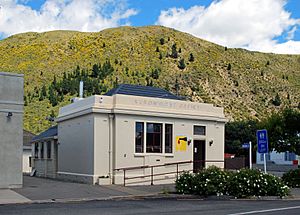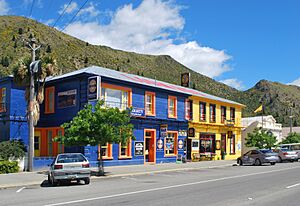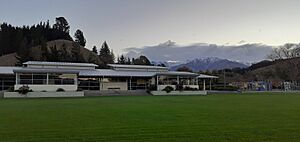Kurow facts for kids
Quick facts for kids
Kurow
Te Kohurau
|
|
|---|---|
|
Rural centre
|
|

Bledisloe St (State Highway 83) in Kurow
|
|
| Country | New Zealand |
| Region | Canterbury |
| Territorial authority | Waitaki District |
| Ward | Ahuriri Ward |
| Community | Ahuriri Community |
| Electorates |
|
| Area | |
| • Total | 2.44 km2 (0.94 sq mi) |
| Population
(June 2023)
|
|
| • Total | 390 |
| • Density | 159.8/km2 (414/sq mi) |
| Time zone | UTC+12 (New Zealand Standard Time) |
| • Summer (DST) | UTC+13 (New Zealand Daylight Time) |
| Postcode |
9435
|
| Local iwi | Ngāi Tahu |
Kurow is a small town in the Waitaki District of New Zealand. It sits on the south side of the Waitaki River. Kurow is about 60 kilometers (37 miles) northwest of Oamaru. The town's name comes from the Māori name for a mountain nearby, Te Kohurau.
Contents
History of Kurow
Kurow was once the end of a railway line. This line, called the Kurow Branch, opened in 1881. It went across the Waitaki River to Hakataramea. However, the line was shortened back to Kurow in 1930. It finally closed in 1983. You can still see where the railway line was, and the old station building is still standing on Liverpool Street.
Hydroelectric Projects
In the 1920s, Kurow was a busy place. It was the base for building the Waitaki Dam. This dam created Lake Waitaki. It was the first of many hydroelectric projects on the Waitaki River. These projects use the river's water to make electricity.
Later, there were ideas for more power projects. These included Project Aqua and the North Bank Tunnel. But these plans did not go ahead.
Social Security Beginnings
An important part of New Zealand's history started in Kurow. The country's first social security plan was designed here. This plan helps workers and their families. It was created by Arnold Nordmeyer, a Presbyterian Minister in Kurow. He saw how families of workers on the Waitaki hydro-electric project needed help.
Farming and Wine
The land around Kurow is used for farming. There are orchards that grow summerfruit. More and more, people are planting Pinot noir grapes. These grapes grow well in the local limestone soil. In 2021, there were 13 wineries and vineyards in the Waitaki valley.
Richie McCaw Statue
Since 2016, Kurow has been trying to get a statue of Richie McCaw. He is a famous All Black rugby captain. The town has been working to raise money for it. At one point, they thought about a seven-meter-tall statue.
People of Kurow
Kurow is a rural settlement. In 2018, it had a population of 372 people. This means there were about 152 people living in each square kilometer.
Most people in Kurow are of European descent (91.9%). About 12.9% are Māori. Many people (36.3%) said they had no religion. About half (50.0%) were Christian.
Hotels in Kurow
Kurow has a couple of historic hotels.
Kurow Hotel
The Kurow Hotel has a long history. Christian Hille opened a place for people to stay in the 1860s. In the 1880s, William Goddard built a larger hotel. It had 24 rooms and a billiard room. It also had stables for horses.
The hotel was damaged by fire in 1892. It was rebuilt using Oamaru stone. The new building had 18 bedrooms and a dining room for 30 people. In 1905, another fire happened. The hotel moved into a nearby hall while repairs were made.
In 1986, the Kurow Hotel was recognized as a Category 2 Historic Place. This means it is an important historical building. You can find it at 55 Bledisloe Street.
Waitaki Hotel
The Waitaki Hotel was built in 1940. It was designed in the Art Deco style. This hotel replaced an older one called the Bridge Hotel. It is located at 37 Bledisloe Street.
Kurow Museum
The Kurow Museum is at 57 Bledisloe Street. It tells the story of the early settlers in the area. It also shows how the social security plan was developed to help families.
Awakino Ski Area
Kurow is the closest town to the Awakino Ski Area. This ski area is about 15 kilometers (9 miles) away. You can get there through Awakino Station.
Education
Waitaki Valley School is a school for younger students. It teaches children from Year 1 to Year 8. As of 2024, it has 184 students.
The school was formed in 2004. It brought together several smaller schools. These included Kurow Area, Otematata, Cattle Creek, and Hakataramea schools. The school moved to its current location in 2012.
Notable People from Kurow
Many interesting people have connections to Kurow:
- Steve Hotton, a rugby player for Otago.
- Roy Kerr, a famous mathematician.
- Richie McCaw, the well-known All Black rugby captain.
- Dr Gervan McMillan and his wife Ethel. They lived in Kurow from 1929 to 1934. Dr McMillan had a medical practice there.
- Arnold Nordmeyer, a politician who became Minister of Finance.
- Charles Saxton, an All Black and rugby leader.
Climate in Kurow
Kurow has a varied climate. Summers are warm, and winters are cool. The area gets some rain throughout the year.
| Climate data for Kurow (1981–2010) | |||||||||||||
|---|---|---|---|---|---|---|---|---|---|---|---|---|---|
| Month | Jan | Feb | Mar | Apr | May | Jun | Jul | Aug | Sep | Oct | Nov | Dec | Year |
| Mean daily maximum °C (°F) | 23.0 (73.4) |
22.3 (72.1) |
20.1 (68.2) |
17.9 (64.2) |
14.1 (57.4) |
10.8 (51.4) |
10.1 (50.2) |
12.2 (54.0) |
15.4 (59.7) |
17.4 (63.3) |
18.9 (66.0) |
20.7 (69.3) |
16.9 (62.4) |
| Daily mean °C (°F) | 16.8 (62.2) |
16.3 (61.3) |
14.3 (57.7) |
11.8 (53.2) |
8.8 (47.8) |
5.8 (42.4) |
5.2 (41.4) |
6.9 (44.4) |
9.6 (49.3) |
11.4 (52.5) |
13.1 (55.6) |
15.0 (59.0) |
11.3 (52.2) |
| Mean daily minimum °C (°F) | 10.5 (50.9) |
10.3 (50.5) |
8.5 (47.3) |
5.7 (42.3) |
3.4 (38.1) |
0.8 (33.4) |
0.3 (32.5) |
1.7 (35.1) |
3.8 (38.8) |
5.5 (41.9) |
7.4 (45.3) |
9.3 (48.7) |
5.6 (42.1) |
| Average rainfall mm (inches) | 55.1 (2.17) |
40.7 (1.60) |
60.8 (2.39) |
28.8 (1.13) |
33.6 (1.32) |
24.6 (0.97) |
34.2 (1.35) |
34.3 (1.35) |
28.2 (1.11) |
47.3 (1.86) |
48.1 (1.89) |
68.8 (2.71) |
504.5 (19.85) |
| Source: CliFlo | |||||||||||||





